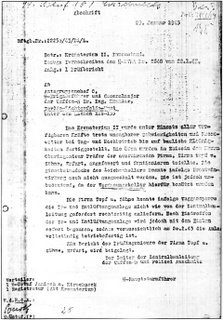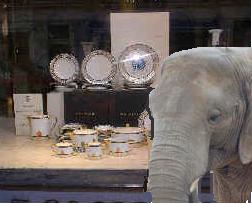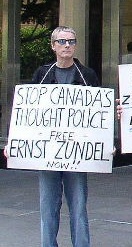
Pathetic Objections to the "Vergasungkeller" document
-Sobe104839-
Whenever Holocaust deniers come across an inconvenient document, they are very quick to either
a) Call the document a forgery without proof,
or
b) Try to make-believe that the document has been misinterpreted by "exterminationists" and that the document itself has a fairly innocent meaning.
One of these documents, a letter, shown to the left, sent from SS-Haupsturmfuhrer Karl Bischoff to SS-Oberfuhrer Hans Kammler on January 29, 1943, a "Vergasungkeller", or "gassing cellar" is mentioned in crematorium two.
Transcription:
Das Krematorium II wurde unter Einsatz aller verfügbaren Kräfte trotz unsagbarer Schwierigkeiten und Frostwetter bei Tag- und Nachbetrieb [sic] bis auf bauliche Kleinigkeiten fertiggestellt. Die Öfen wurden im Beisein des Herrn Oberingenieur Prüfer der ausführenden Firma, Firma Topf u. Söhne, Erfurt, angefeuert und funtionieren [sic] tadellos. Die Eisenbetondecke des Leichenkellers konnte infolge Frosteinwirkung noch nicht ausgeschalt werden. Die [sic] ist jedoch unbedeutend, da der Vergasungskeller hierfür benützt werden kann. Die Firma Topf u. Soehne konnte infolge Waggonsperre die Be- und Entlüftungsanlage nicht wie von der Zentralbauleitung gefordert rechtzeitig anliefern. Nach Eintreffen der Be- und Entlüftungsanlage wird jedoch mit dem Einbau sofort begonnen, sodass voraussichtlich am 20.2.43 die Anlage vollständig betriebsfertig ist.
Ein Bericht des Prüfingenieurs der Firma Topf u. Söhne wird beigelegt.
Translation:
Except for some minor construction work, Crematorium II was finished by working with all our available forces day and night, despite inexpressible difficulties and freezing weather. The ovens were fired in the presence of the senior engineer Prüfer of the executing firm, Topf and Sons, Erfurt, and they are working faultlessly. The reinforced concrete ceiling of the morgue could not yet be eliminated due to the freezing weather. However, this is not significant, as the gassing cellar can be used for this purpose. Due to the railway car prohibition, the company Topf and Sons could not deliver the aeration and deaeration equipment at the time demanded by the Zentralbauleitung. After the aeration and deaeration equipment arrive, however, installation will begin immediately, so that presumably by February 20, 1943, it will be completely ready for operation.
Enclosed find a report of the inspecting engineer of the firm of Topf and Sons."
Unsurprisingly, deniers come up with contradictory explanations for this damning document. I love it when they can't agree, it so clearly demonstrates that "revisionism" is not a theory but an attack on truth. Just as any stick will serve to beat a Jew, any lie will serve to contradict a historian. They don't really know what the "Vergasungskeller" was -- they just "know" what it wasn't. So, let's look at the explanations that deniers have to offer for this damning, incriminating document.
First, and foremost, Prof. Arthur Butz. In his 1976 book The Hoax of the Twentieth Century, Butz wrote that "Vergasungkeller" was a gas production room to make gas to keep the ovens running. The problem? The Auschwitz ovens did not run on gas, they ran on solid coke. Ooops! Somehow, Butz did not realize this. Then, comes Butz's second explanation: [3]
"I have never seen the word "Vergasungskeller" in a lexicon; indeed I have
seen it only in discussions of NO-4473! However I have seen two German-Russian
dictionaries, one a military dictionary, that say "Gaskeller" means "gas
shelter". However we should not consider ourselves bound to dictionaries on
this. If one asks the question: In a World War II military context, what might
"Vergasungskeller" and/or "Gaskeller" mean?, I think that "gas shelter" is the
answer that comes naturally to mind, and that other meanings are somewhat
strained. Of course other meanings come naturally to mind in non-military
contexts."
Butz fails to offer any evidence for such shelters in Auschwitz and in other camps, which would be, after all, the central point of his argument. The only support for his interpretation is that two dictionaries mention "Gaskeller" as translation for "gas shelter". Very strangely for an experienced author and academic, he goes on without much consideration and identifies two very different words as synonyms. "Vergasungskeller" is "Gaskeller", therefore "Vergasungskeller" is "gas shelter". Full stop. No evidence needed.
Did Butz even consult a German speaker? I doubt it. Not knowing German myself, I asked some German speakers what "Vergasungkeller" means. They said that “Vergasungkeller" literally translates into “gassing cellar”, whether Butz likes it or not. To quote one German speaker, “any other interpretation is bullshit”. Clearly, if Bischoff wanted to describe a gas shelter, he would have used the unambiguous "Gasschutzkeller" instead of "Vergasungkeller", which is also unambiguous and has a completely different meaning: gassing cellar. [3]
We have five customers left. Germar Rudolf and Wilhelm Staeglich both claimed that the "vergasungkeller" document referred to an air-raid shelter. [4]
Here's the problem with this explanation: It is obvious that the "alleged" gas chambers could never have served as air-raid shelters for an inmate population of 100,000 or more, even if it thought likely that the SS should have wanted to protect the inmates against air-raids. Therefore, if the leichenkellers were ever intended to be used as air-raid shelters, they must have been intended for the SS. In fact, crematoria II and III are about one and a half miles from the nearest SS barracks. The picture of SS personnel running from their barracks, round the perimeter wire, in full gear, one and a half miles to the crematoria, under a hail of bombs, is just plain daft. [5]
Carlo Mattogno. Sometimes said to be the leading revisionist wordwide. Mattogno's explanation for this document is that it refers to a gassing cellar, indeed-but not a homicidal one: [6]
"The term Vergasungskeller designates a
disinfestation basement. In the explanatory report on the construction of KGL
Birkenau dated 30 October 1941, the two Zyklon-B Entlausungsbaracken
(disinfestation installations) subsequently built, BW5a and 5b are equipped with
a Vergasungsraum. [77] "
Again, there is no evidence whatsoever to support this theory. Not even one piece of evidence. The inventory of crematorium two upon its completion reveals "four wire-mesh introduction devices" and "four wooden covers." These were the apparatus through which the Zyklon-B was poured into the gas chamber. While the inventory list matches independent eyewitness testimony regarding the way the Zyklon-B was placed in the chamber, it corroborates nothing about Mattogno's explanation. If Mattogno wants to make-believe that the "Vergasungkeller" refers to a disinfestation basement, he has to explain where these four wire-mesh introduction devices and four wooden covers would have gone. Something that would also be appreciated is how Mattogno would answer the following question: If many Auschwitz eyewitnesses lied, including those who told of the gas chamber in crematorium two, why does this document support independent eyewitness testimony which also states that four introduction devices where used?
Robert Faurisson is usually said to be the leading "revisionist" scholar in Europe. In 1989, Robert Faurisson offered the idea that the cellar was a storage area for fumigation supplies. [7]
One wonders why, if the cellar was used for storage, did Bischoff refer to the cellar as "Vergasungkeller". As with all the alternate explanations offered by "revisionists", there is no evidence whatsoever to support this claim. I, on the other hand, as well as whoever accepts the Holocaust as a fact, have/has a huge convergence of evidence to support my/their theory. The "revisionists" have none. Let them try to find evidence that the gas chambers where anything but gas chambers. They haven't and will not find any.
Just give me one proof, Mr. Faurisson. One proof that the gas chambers were something else.
So, the real question we have to ask Mr. Faurisson is:
"Show me or draw me an air raid carburetion shelter delousing morgue!"
Our last customer is Carlos W. Porter. He made up the funniest explanation- that the document itself is a forgery. [8] To declare something a forgery, you need to have something called p r o o f, which should support your theory. Now, what's Porter's proof that the document itself is a forgery?
1) that the document uses "vergasungkeller"- a term that "appears to be nonexistent in German", according to Porter. [9]
Keep in mind that Porter doesn't know German. He is just making false speculations. It is quite simple really. "Keller" means "cellar", or "basement". "Vergasung" means "gassing". So, when you put these two words together, what does it mean? Gassing cellar. Just to find extra support for my argument, I simply typed "German" on google. It is a simple matter of scrolling down after searching "German" in google, were one sees a website called "The New German/English Dictionary". One then types "Vergasung" and "keller" on the search bar of the website. It's so unbelievably simple, and thus amazing to think that some of the "revisionist" pioneers couldn't even google "German" like I did, or "German dictionary", even more obvious when interpreting that "vergasungkeller" document. [10]
2) that several signatures made by the same person(s) look differently: [11]
Are these two signatures by the same person? To me, the first looks like a
natural signature; the second one looks like a long, slow, crude tracing job
using a flat, round nib (used by artists to achieve a uniform line, or, in this
case, to disguise the direction and pressure of the strokes ). Compare, in
particular, the "tail" on the "k". The strokes do not appear to start and stop
in the same places, or with the same amount of pressure. Instead, the lines are
uniformly curved and rounded, like a neon sign.
This is hilarious, isn't it? So, because a few signatures by one person don't look exactly the same, the document itself is a forgery? To me, the signatures look diferent because people are not robots, and when somebody writes at different moments, their letters and writing might actually look different! (heavens alive!)
In conclusion, if you view this document by itself, it is possible to interpret "Vergasungkeller" as a gassing cellar - but for gassing clothes, not people. However, if one looks at ALL the evidence available, one will find out that the ONLY reasonable interpretation for "Vergasungkeller" is a homicidal gas chamber.
What did I do to interpret "Vergasungkeller"?
I looked at all the evidence available on the subject. I looked at eyewitness testimony, pictures, court statements, etc. All the available evidence converges on my interpretation that there was a homicidal gas chamber in crematorium II, and that this is what Bischoff was reffering to.
What do Holocaust deniers do to interpret "Vergasunkeller"?
They immediatley ignore another interpretation (mine) which has all types of evidence supporting it. Instead, they pick a conclusion with NO evidence to support it. Not one photo, not one testimony, not one document, etc - NOTHING.
When ANYBODY makes a reasonable assertion, they need to give something called p-r- o-o-f so that we know that their assertion is not an opinion, but a fact. For all we know, the deniers' interpretation can simply be an opinion, because they offer not one shred of proof for their interpretation.
The funniest thing is that some deniers actually think that their interpretation is more reasonable than mine. ;-)
I'll leave it up to the reader to decide for him/her self whom's interpretation is more reasonable:
mine (all types of evidence supporting it)
the deniers' (not one shred of evidence supporting it, rejects my interpretation which has all types of evidence supporting it for no reason)
------------------------------------------------------------------------------------------------
Endnotes:
[1] THHP on the "Vergasungkeller" document
[2]Arthur Butz's "explanation" for the "Vergasungkeller" document
[3]A refutation of Butz's "Vergasungkeller" explanation
[4]Robert Jan Van Pelt's refutation of "The Rudolf Report" by Germar Rudolf
[5]Robert Jan Van Pelt's refutation of "The Rudolf Report" by Germar Rudolf
[6]Carlo Mattogno's "Vergasungkeller" document explanation
[7]A refutation of Butz's "Vergasungkeller" explanation
[8]Carlo Porter's "explanation" for the "Vergasungkeller" document
[9]Carlo Porter's "explanation" for the "Vergasungkeller" document
[10]The New German/English on-line Dictionary
[11]Carlo Porter's "explanation" for the "Vergasungkeller" document



